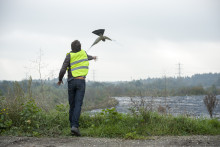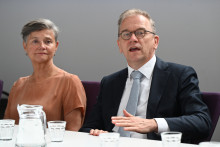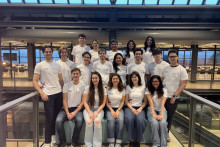 |
| The crowded city of Istanbul experienced a major population explosion in recent decades. Nearly 12 million inhabitants live in the eastern and western areas, compared to only 1 million people just 50 years ago. The inner city’s developing areas and suburbs on the outskirts are almost as densely populated as Manhattan city, roughly 2,333 inhabitants per squared kilometer, requiring planners and politicians to take advantage of new technologies to create future models to develop and preserve the historical areas and ancient monuments. ITC in Enschede is one of the higher educational institutes conducting fieldwork to improve the quality of urban planning and development in Istanbul. |
The center prepares supra-scale plans projected for 2023 and short-term plans, affecting the development of the world’s narrowest strait, the Bosphorus that connects the Black and Marmara Seas. Booming development, traffic congestion and population growth along Istanbul’s coastal areas requires different types of technical studies to address future problems.
On a recent visit to the ITC, the photogrammetry specialist discussed ways to further develop cooperation between the institute and IMP. His trip laid the building blocks to give rise to an ‘exchange of knowledge’ platform, developing together possible topics for the next group of master students.
A new research group is scheduled to leave in September 2010 to conduct research in Istanbul after a successful initial trip last year when Büyüksalih and his colleagues provided the practical elements, opening the doors of the IMP Center to welcome the first group of ITC students. The native of Trazbon expressed his thoughts on the future of Istanbul in an interview.
This is your first time in the Netherlands. What are the main objectives of your visit?
‘The ITC is a high-level institute. Many research projects are carried out here. There are always new ideas being generated and new technologies which are being applied to urban management and development projects. One of the aims in our cooperation with the ITC is to gain knowledge and new ideas because we know our problems, and they are also involved in our problems and can possibly provide solutions.’
How does the cooperation work between the ITC and the IMP?
‘What I’ve told them is that I will supply your researchers with everything if you can offer us new ideas about how to solve our problems. We can look at our problems from a different perspective with different knowledge which brings us in the right direction. If we choose to do everything on our own, we will not develop. We cooperate with different international institutions, not only the ITC. We can increase our level and the students can also increase their level by dealing with the real problems. We operate project groups, but you always need the connection to the universities. The ITC gives us ideas to stimulate our planning side.’
What are the main problems?
‘One example is the informal settlement growth which has happened in the past through migration pressure. In Istanbul the situation occurred when people “came in the middle of the night” and settled. We have public land and people just came and lived there without having a legal building permit. But now the illegal settlement problem has been reduced to a low level, around 1 percent. The real peak we saw back in the 80s and 90s, but later the municipalities took strong measures against it and made laws to prohibit these illegal constructions.
‘We now have a problem with people illegally building more levels on top of existing buildings to add on additional floors. For instance, officially, there are six stores, but they construct seven or eight. This is the major problem. The local population is beginning to show a reaction. They don’t like it, and now the situation is beginning to stabilize.’
What are the aspirations of Turkey for the coming years in terms of urban planning and development?
‘Many long-term planning project goals for Istanbul are projected for the year 2023, the year when Turkey celebrates its foundation as a republic since 1923. It’s the main strategic planning year. More recently, Istanbul was recognized as the European Capital of Culture. And last year, the municipality created a metro bus route–starting from the west side of Istanbul and going to the east side of Istanbul. Tourists and locals can travel in 40 minutes from the west side to the east side.’
What else are you working on at the IMP Center?
‘Our most recent project for the Municipal Urban Planning group is along the seaside area. Using the latest technologies, we can visualize the placement of cruise ships and analyze possible scenarios. If cruise ships dock at the port then it cuts the view of people living in the buildings. You can visualize future situation in 3D images, otherwise you get a solid model. We need the new modeling to analyze. The data offers the ability to create three- dimensional geometrical designs on the computer.’
Are you planning any other projects in the peninsula of Istanbul?
‘We are not only doing planning at the IMP, but we are also working on cultural and historical management. There is a historical peninsula in Istanbul, which is now combined from two former districts to one main district called the “Fatih District”. In this district alone, there are almost 50,000 buildings and 11,000 of them hold historical importance and need to be preserved. The area is recognized as a registered UNESCO- protected area. The current project, where we document historic buildings by using the latest laser-scanning technology, and then we draw 3D models from the collected data. We can drive through whole streets and record data.’
Istanbul is located on a fault line and scientists predict an earthquake will happen in the future. What do you imagine will happen?
‘They are expecting an earthquake but this fact is not relevant, not important. We only need to realize that we are living in a region with the potential to experience an earthquake, and we need to take certain precautions. As urban planners, we have to create and develop projects that protect people against a possible earthquake. The IMP Center creates and provides the specific information, Geo-spatial information based on geography. We need to collect the right data for accurate urban planning and management.’
 |
| The Istanbul Metropolitan Municipality Planning and Urban Design Center collects 3D laser scanning data that is later used for digital architectural drawings and transformed into 3D modeling and rendering. |
 |
 |
 |
 |







